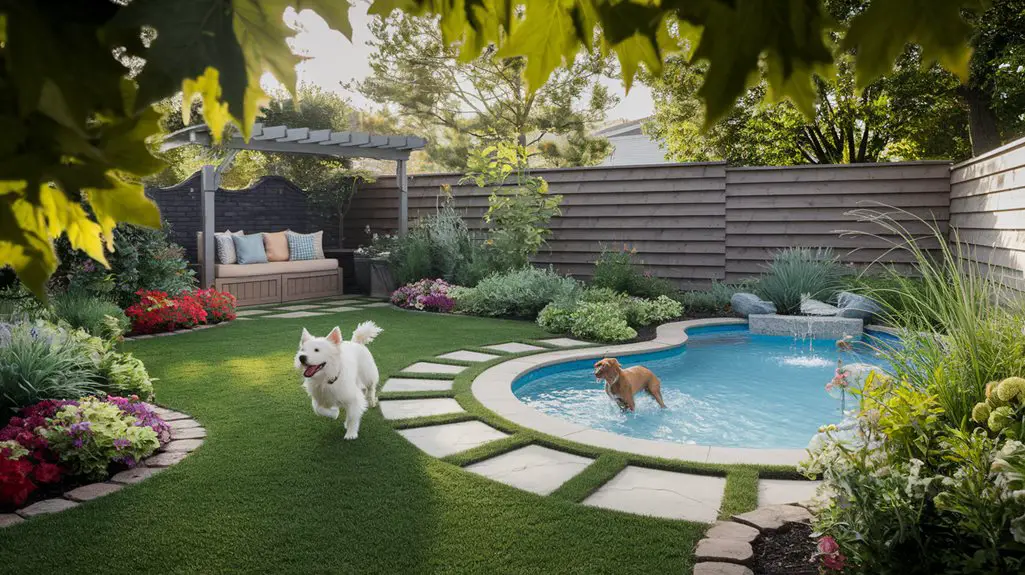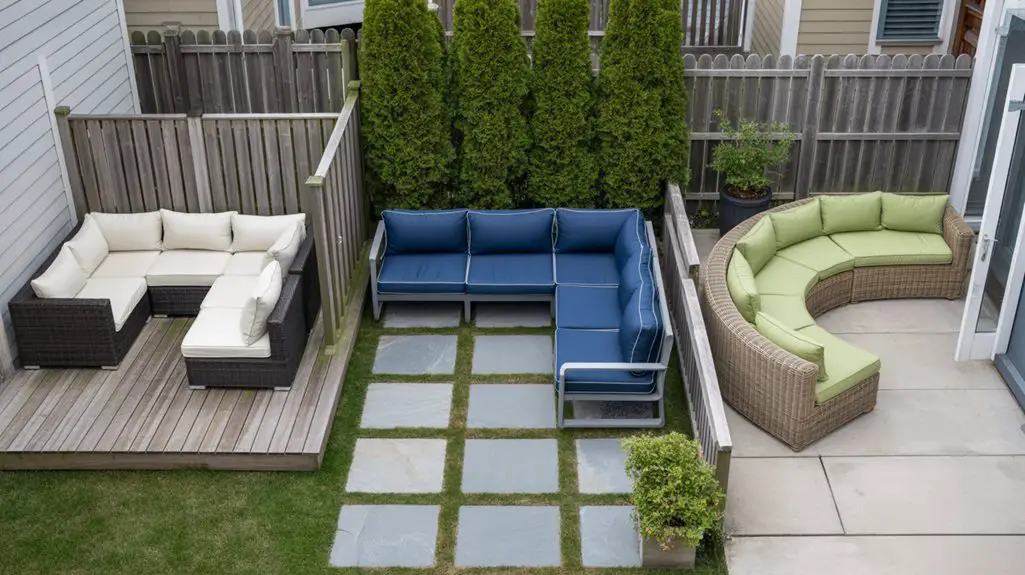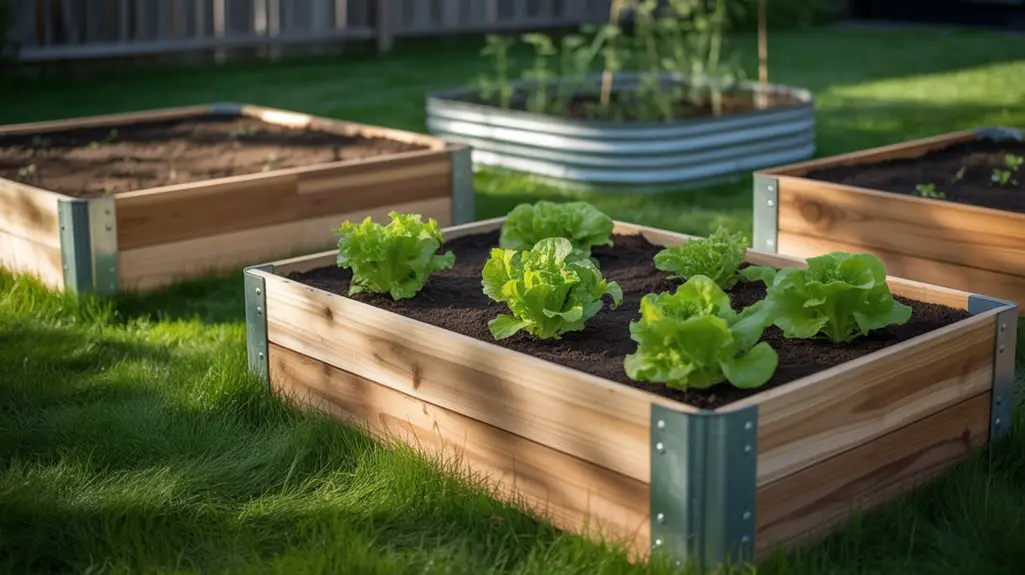Meet Max, a two-year-old Labrador who transformed from an anxious, destructive digger into a contented companion after his owners redesigned their backyard with his needs in mind. You’ll face similar challenges if you’ve got an energetic dog confined to a standard yard. Creating a pet-friendly outdoor space isn’t just about aesthetics—it’s about safety, enrichment, and preventing behavioral problems before they start. These seven practical tips will protect both your landscaping and your furry friend’s wellbeing.
Choose Dog-Safe Plants and Landscaping
When designing a dog-friendly backyard, your first priority should be selecting non-toxic plants and appropriate landscaping materials. Avoid toxic species like azaleas, lilies, and foxglove that can cause severe reactions if ingested. Instead, opt for pet-safe alternatives such as sunflowers, roses, and snapdragons.
For ground cover, select sturdy grasses like Kentucky bluegrass or Bermuda that withstand paw traffic. Install designated paths using rounded pea gravel rather than sharp rocks or mulch that splinters. Avoid cocoa mulch, which contains theobromine toxic to dogs.
Create boundary areas with dog-resistant shrubs like barberry or densely planted ornamental grasses. Consider raised planters for delicate specimens. Additionally, be sure to check for low-maintenance pet-friendly yard solutions that can help simplify your landscaping efforts.
Remember that fertilizers, pesticides, and herbicides can harm pets, so use only pet-safe products labeled accordingly.
Create Shade and Shelter Zones

Since dogs need protection from extreme weather conditions, establishing strategic shade and shelter zones is essential for their outdoor comfort and safety. Install a waterproof doghouse with proper insulation and ventilation in a location that’s protected from prevailing winds. Consider adding elevated platforms or cots where your dog can rest above hot surfaces during summer months. Additionally, incorporating sustainable backyard designs can enhance both your dog’s environment and the overall eco-friendliness of your space.
| Shelter Type | Benefits |
|---|---|
| Pergola | Filtered sunlight, decorative appeal |
| Shade sail | Easy installation, UV protection |
| Natural trees | Air cooling, seasonal shade |
| Covered porch | All-weather protection, proximity to house |
| Doghouse | Privacy, insulated refuge |
Position these elements throughout your yard to provide shade options as the sun moves throughout the day. You’ll also want to make certain there’s always fresh water available in shaded areas to prevent dehydration.
Install Secure Fencing and Boundaries

A proper containment system forms the foundation of any dog-friendly backyard, ensuring your pet’s safety while preventing unwanted escapes. Choose fencing that’s appropriate for your dog’s size and jumping ability—generally at least 6 feet high for large breeds or athletic jumpers.
Install dig guards by burying chicken wire or concrete blocks 12 inches below the fence line. Inspect your fence regularly for gaps, loose boards, or eroded areas beneath the boundary.
Gate latches should feature secure mechanisms that can’t be nudged open by a determined muzzle. Consider boundary reinforcement with landscaping barriers like dense shrubs placed inside the fence perimeter. For tech-savvy owners, invisible fence systems can provide secondary containment, though they shouldn’t replace physical barriers. Remember: your fence isn’t just for containment—it also protects your dog from outside threats. Additionally, you might want to consider using eco-friendly materials for your fence to create a sustainable and safe environment for your pet.
Design Dedicated Digging Areas
Many dogs have a natural instinct to dig, making dedicated digging zones essential for channeling this behavior constructively rather than destructively. Create a designated sandbox using child-safe sand in a shaded area of your yard. Border it with smooth landscape timbers or boulders to clearly define boundaries. Additionally, incorporating backyard design for multiple pets can enhance the overall experience for both your dog and other animals.
| Material | Benefits | Maintenance |
|---|---|---|
| Sand | Soft on paws, drains well | Replace annually |
| Soil/Mulch Mix | Natural feel, holds toys | Refresh quarterly |
| Wood Chips | Insect-repellent, stays cool | Top off monthly |
| Pea Gravel | Won’t stick to fur, drainable | Check for sharp edges |
| Loam | Holds scent for treasure hunts | Needs regular turning |
Encourage digging in this zone by burying favorite toys or treats. Redirect your dog immediately when digging occurs elsewhere, then guide them to their designated area.
Include Water Features for Cooling Off
Water features serve as essential cooling stations for dogs during hot weather, preventing overheating while adding aesthetic appeal to your backyard sanctuary.
Install a shallow dog pool with gently sloped sides for easy entry and exit. Select non-slip materials that withstand paw traffic and regular cleaning.
Consider incorporating a dog-specific fountain with a motion sensor or paw-activated mechanism to encourage hydration throughout the day.
For larger yards, a carefully designed splash pad with recirculating water systems minimizes waste while providing interactive play opportunities.
Always position water features in partially shaded areas to keep water temperature comfortable and reduce algae growth.
Install proper drainage systems to prevent standing water and mosquito breeding.
Use non-toxic sealants for all water features, ensuring your cooling stations remain safe for enthusiastic canine splashing. Additionally, ensure that all water features are designed with pet-friendly materials to promote a safe environment for your furry friends.
Build Pet-Friendly Pathways and Play Areas
Strategic pathways and designated play zones form the backbone of a dog-friendly landscape, connecting different areas while encouraging healthy exercise and exploration.
Choose decomposed granite or mulch for pathways—both provide good drainage and won’t hurt paws. Avoid sharp gravel or cocoa mulch, which is toxic to dogs.
Create dedicated digging zones using sandbox-style enclosures filled with sand or soil, and bury toys occasionally to encourage natural foraging behaviors.
Install agility equipment like hurdles, tunnels, or weaving poles that you can customize to your dog’s size and ability level.
Position these elements along the perimeter of your yard to create a natural circuit that satisfies your dog’s instinct to patrol boundaries.
Add varied terrain features—small mounds or steps—to build muscle strength and balance during play. Additionally, incorporating varied terrain features enhances physical and mental stimulation, making your backyard a more engaging environment for your dog.
Add Comfortable Outdoor Resting Spots
Dogs need comfortable resting areas throughout your yard where they can relax while still keeping you in sight.
Create multiple designated spots that offer both shade and sun options, allowing your pet to regulate their temperature naturally throughout the day.
- Install an elevated cooling bed in shaded areas to keep your dog comfortable during hot days while providing airflow underneath.
- Place weather-resistant dog mattresses on covered patios with washable, waterproof covers for easy maintenance.
- Create a sandbox pit bordered with cedar planks where dogs can dig and rest on cooler earth during summer months.
- Mount a custom window perch near ground-level windows so your dog can monitor indoor activities while enjoying outdoor air.
Additionally, ensure that these resting spots are located in backyard zones for pet relaxation to maximize your dog’s comfort and enjoyment.
Conclusion
Your dog-friendly backyard isn’t just a space—it’s your pet’s sanctuary. Design with purpose, build with durability, and maintain with vigilance. You’ll create not only a secure environment but also an enriching habitat where your dog can explore, rest, and play. Transform your yard today: plant strategically, fence methodically, and integrate comfort deliberately. Your careful planning guarantees your canine companion thrives in their outdoor domain.




